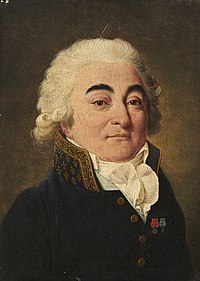Marie-Gabriel-Florent-Auguste de Choiseul-Gouffier

Marie-Gabriel-Florent-Auguste de Choiseul (27 September 1752,
Biography
Right from his studies at the
In 1776, he left for Greece on board the frigate Atalante, commanded by

Choiseul-Gouffier visited Athens, where he coveted the
The
He only returned to France upon
Works
He published his impressions as Voyage Pittoresque en Grèce (Brussels 1782), often reprinted, and republished as late as 1842, as Voyage pittoresque dans l’Empire Ottomane. It presented many little known monuments, set in an idealised Greece crushed by Ottoman domination and desiring to rediscover and reawaken its liberty. This romantic vision of modern-day Greece was taken apart by several other travellers at the start of the 19th century. Like them, he suggested one should go see these sites in person to better comprehend the ancient authors, walking round sites with their texts in one's hand, "to feel more live the different beauties of the pictures traced by Homer, by seeing the images he had in his eyes" ("pour sentir plus vivement les beautés différentes des tableaux tracés par Homère en voyant les images qu'il avait eues sous les yeux"). His narrative allowed his readership to get to know previously unknown regions of Greece, such as the Cyclades. He asked his protégé, the painter Lancelot-Théodore Turpin de Crissé, to produce the engravings for the second volume.
His other works include a Dissertation sur Homère, a
References
- "Marie-Gabriel-Florent-Auguste de Choiseul-Gouffier", in Marie-Nicolas Bouillet et Alexis Chassang (dir.), Dictionnaire universel d'histoire et de géographie, 1878
- Biography, from the Académie française site
- Elisabeth A. Fraser, Mediterranean Encounters: Artists Between Europe and the Ottoman Empire, 1774-1839, Penn State University Press, 2017. ISBN 978-0-271-07320-0
- Notes
- ^ (in French) Chantal Grell, "Les ambiguités du philhellenisme: L'ambassade du comte de Choiseul-Gouffier auprès de la sublime porte (1784-1792)" Dix-huitième siècle, 27 (1995) pp 223-235.
